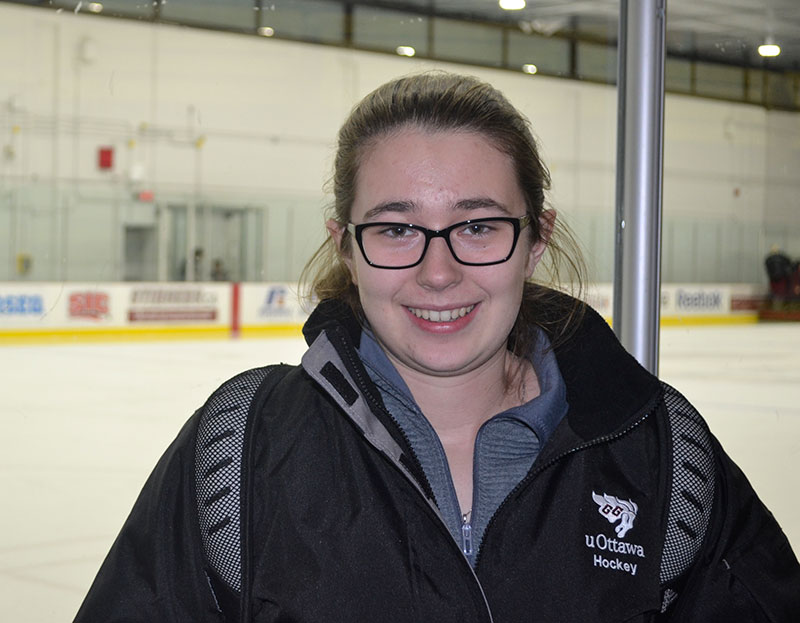Sexism in sports nothing new
When Megan Halhed was 15, a coach told her to move out of the way for real players because girls can’t play hockey. She was about to go on the ice with her co-ed team, when the incident happened.
Halhed, 20, is a nursing student at the University of Ottawa, and a goaltender for the Gee-Gees women’s hockey team. She discovered her love of the sport at age 10 when her mother brought her to the arena to learn how to skate. She immediately fell in love with hockey, and played on a boys’ team until 2011. She said her family has always encouraged her.
When the Canadian tennis star Eugenie Bouchard was asked to twirl on the court at the end of one of her matches at the Australian Open, Jessica Schnurr and Hannah Smith, who both work for an advertising company in Toronto, decided it was time to do something.
They launched a social media campaign #CoverTheAthlete and created a video that’s been viewed 1.5 million times since it was launched on YouTube three weeks ago. According to Schnurr and Smith, there needs to be a change in narrative for media coverage of female athletes. The campaign criticizes how the media portrays female athletes, often in a sexist way.
“They’ll realize that the public wants better coverage and better questions asked of these athletes, and they’ll kind of rise to the occasion, and start asking better questions,” Schnurr said.
She said the media should spotlight the performance instead of the athlete’s physical attributes, hair or clothing.
According to research by Kristin Wilde, a researcher at the University of Alberta, specializing in women and gender studies, women are often hesitant to get involved in sports because of the difficulty of challenging gender stereotypes. Her research states that sports are still perceived as a man’s domain.
Halhed, who grew in Ottawa, said she doesn’t think a movement like #CoverTheAthlete will have an impact on the way female athletes are treated, and that the sexism is always there.
In a recent study by the University of Minnesota’s Tucker Centre for Research on Girls & Women in Sport, the United States has 40 per cent female representation in sports, but women receive only four per cent of media coverage. No similar research exists in Canada.
Halhed said women’s hockey doesn’t get as much attention as its male counterpart, but with the advent of the Canadian Women’s Hockey League, the coverage “will get there.”She thinks women hockey doesn’t receive a lot of media coverage “because we are not men.”
At their last game Gee-Gees defeated the Concordia Stingers 4-1. Halhed was sitting in the stands, notepad in hand, counting statistics for her coaches. In her first year with the Gee-Gees and in a three goaltenders’ rotation, she hasn’t played yet.
“When you watch the game, it’s actually very good,” Halhed said. “We are here for the game, there are no fights.”
Schnurr said the point of the campaign is to get the media asking better questions, and that this is feasible for every journalist. She said #CoverTheAthlete is not seeking more media coverage of sport, because the lack of coverage is an issue in itself.
Courtney Cameron is a Carleton master’s student in anthropology who’s studying the experience of being an amateur sportswoman in Canada. She said she thinks #CoverTheAthlete could definitely start a conversation about the coverage of women in sports.
“Women don’t openly discuss very often their difficulties and the troubles they experience as female athletes,” she said. “I think the #CoverTheAtlete movement on social media and other comparable social media movements would be really great in getting the conversation started, and getting more people aware of the issues that are faced by female athletes at the professional and the amateur level.”
She said she found that very few of the female athletes who participated in her research were comfortable enough to identify themselves as an athlete. They were all troubled by the media focus towards the female body and were unhappy with the lack of coverage or the lack of attention to their sport.
“It is not as easy for girls as it is for young boys to find an athletic model in the media,” Cameron said.
Throughout her research, Cameron discovered that the availability of programs for young girls to participant in is very small in comparison to boys, and that the encouragement young girls receive to participate in sports is not the same as it is for boys. She added that the effects of sexism are very subtle, stemming from boys being more encouraged to get involved in sports than girls.
She said that a huge part of the problem is the ideals of masculinity and femininity. “It could affect her behaviour outside the arena, and also the way they are treated,” Cameron said.
Schnurr emphasized that the most important thing for #CoverTheAtlete is for the media to realize that the public wants better coverage and better questions asked. She said journalists need to ask better questions.

